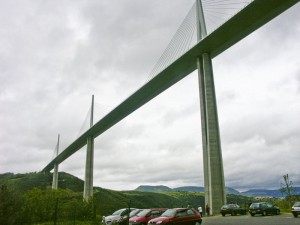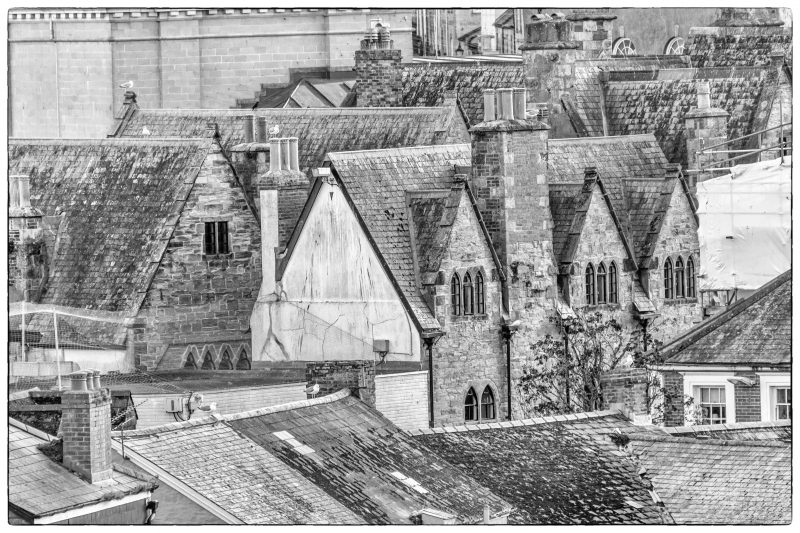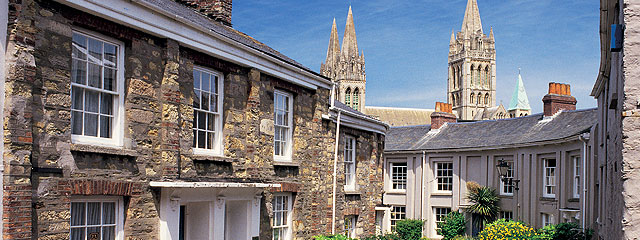“To kill two birds with one stone”
(Many thanks to Mike Burgess for submitting this thought provoking article)
A few thoughts on a strategic plan to deal with possible threats to Truro
Since the global financial crisis it looks as though plans to stop global warming have stalled. The evidence is all around, stiff opposition to wind turbines and higher fuel bills. Political arguments over where to site new runways for London to accommodate ever more flights; a fully loaded jumbo jet takes off with 50,000 lbs of jet fuel, all to be burnt high in the atmosphere, it must add to greenhouse gas levels. It is not surprising that the political class has put the issue on a back burner, asking for sacrifices in the face of a nebulous and far off threat does not make for popularity. Also our economy is small compared some rapidly growing economies
(The BRICs) which will produce vast amounts of additional green house gas; so what would be the point of burdening ourselves? Nevertheless the potential difficulties may become all too real for the generation that are at school in Truro today. We owe it to them to take the matter seriously.
Part of the problem for decision makers is the scientific uncertainty that surrounds the issue. There will be a sneaky quality to climate change. If and when it comes it may not follow any of the current predictive models. It will catch out governments and individuals. It could be brutal. The IPCC s Fourth Assessment Report has central predictions of temperature rises between 2C and 4C and up to a 17% chance of rises above 4.5C.
One study shows an uncomfortable 10% chance of rises of 6.8C or more. The IPCC projected forward, past data on rising sea level; eight inches in 100 years, this points to rises of less than a meter over the next 100 years.
This may not be the whole story; the IPCC are reluctant to speculate in areas where they have not gathered hard data. Global emissions over the next few decades are also an unknown. Also climate systems are by nature non-linear, there will be feedback loops. James Lovelock, a renowned climate scientist who lives near Launceston wrote several books about these feedback loops. Perhaps the two most powerful would be absorption of additional heat from the sun as the ice covering is melted off dark coloured rocks and sea; another would be the release of frozen methane, a powerful greenhouse gas, from under the sea and the frozen tundra of Northern Russia and Canada, as temperatures rose. Other scientists includi ng Martin Rees, President of the Royal Society have endorsed this approach.
It is not possible to carry out scientific experiments to solve this problem, so there can be no certainty. A possible guide is to look at what happened to Earth during a previous warming. Temperature was a degree or two warmer 125,000 years ago due to changed orbital dynamics of the Earth around the Sun. Sea levels then were four to six meters (20 feet) higher. A temperature rise of say four degrees or six degrees may make matters much worse.
The scientific community are now very sure that global temperatures are rising; all 11 years of this century have been amongst the hottest on record. Greenhouse gases, once in the atmosphere, can take tens of years to dissipate, in addition mankind is adding to them at an uncontrolled rate as the world population grows and other countries come to enjoy the higher standard of living that we have in the West; it may take decades to turn this around. There are some that now advocate preparations to mitigate what is to come as it may already be too late to stop the changes in time.
Cornwall is lucky. Most of the land is well above sea level and the climate is quite mild. This summer we might have had a taste of the future, we have had unsettled weather, long dry periods followed by weeks of heavy rain. Pictures on our TVs of the rapid melting of glaciers in Greenland and the sea ice of the Artic are very unsettling. Local temperatures in Cornwall may rise or fall, depending on what happens to the Gulf Stream. Melting ice from Greenland could switch off this circulation of ocean currents. Lizard Point is, after all, on the same line of latitude as St Johns in Newfoundland, which has very severe winters. So far the scientific evidence is inconclusive. The robust folk of Cornwall will no doubt cope with all these vicissitudes, except one. Rising sea levels.
Recently £ 3million has been spent on improving Truro docks and raising the flood barrier on the dockside, it is now 1.2meters high. If it is overtopped it will be when a maximum high tide coincides with low atmospheric pressure and a stormy onshore wind. Then there may be a gap of days, weeks, months, even years; then these circumstances will be repeated and it will happen again. Over time, with rising sea levels, floods will become more frequent causing greater damage in the city each time. Imagine standing at High Cross and the sea has reached the lip of the door and is pouring into the Cathedral, look around and assess the cost of the damage that will have occurred to all the buildings and livelihoods in the centre of Truro. That is what a sea level rise of 6m will look like. We may need to prevent this happening.
At the same time traffic levels on the main roads into Truro at peak times, despite the park and ride, are becoming unbearable. Further house building all over the city will only make it worse. So a new road to take some of the pressure off the A390 through Highertown and Tregolls Road would also be welcome. This is a proposal to combine the two projects by building a barrier across the river near Boscawen Park and to run a new bypass road over the top of the barrier.
 Man made artefacts do not have to be ugly; they can often enhance the environment. My favourite is the Millau Viaduct over the River Tarn in France, but Truro cathedral and the railway viaducts across the city also improve the view. A solid barrier across the river could have a pleasing shape. It could be faced with Cornish granite and topped with a handsome balustrade such as those on the Thames embankment. If river traffic into the Truro basin was to continue there would have to be a gap with a rising or swing bridge, common in East Anglia and Holland. In the gap there could be a lock gate. This could be fully raised at times of threat and could be used to adjust water levels in the harbour to suit changing circumstances in the future.
Man made artefacts do not have to be ugly; they can often enhance the environment. My favourite is the Millau Viaduct over the River Tarn in France, but Truro cathedral and the railway viaducts across the city also improve the view. A solid barrier across the river could have a pleasing shape. It could be faced with Cornish granite and topped with a handsome balustrade such as those on the Thames embankment. If river traffic into the Truro basin was to continue there would have to be a gap with a rising or swing bridge, common in East Anglia and Holland. In the gap there could be a lock gate. This could be fully raised at times of threat and could be used to adjust water levels in the harbour to suit changing circumstances in the future.
The line of the new road would obviously be subject to detailed survey. The aim would be to link the main road into Truro near the site of the new Waitrose in the East, with the A39 from St Austell at Union Hill and the A39 to Falmouth near Arch Hill. This would divert a lot of traffic from the centre of town. A second phase would link this road from a roundabout near the old railway bridge at Arch Hill to the site of Richard Lander School in the West. This would reduce the traffic jams on Highertown road allowing more free movement of local traffic. A single carriageway road would probably be sufficien t but at least one cycleway in parallel with the whole route would allow bikers to cycle safely the length of the city and connect the college and the two secondary schools.
What follows is a series of observations concerning aspects of this new road:
1. The road would form a natural planning boundary to the east and south of the city, and would have to be sited accordingly.
2. From Waitrose to Sunny Corner it would have to cross some agricultural land. This route would be about 3000m, a bit more if it skirted round the back of Penair School.
3. The hill down to Sunny Corner would be quite steep, the barrier across the river would need to be about 10m above the current High Water Mark, and this would reduce the slope a little.
4. The road would cross a bridge on the barrier, below which could be some lock gates. These could be conventional or similar to the hollow rotating cylinders used on the Thames barrier. This gate could be closed if the city was threatened by a very high tide. Also it could be shut at low tide if the city was threatened by heavy rain running into the three rivers. This would provide an empty basin to absorb the flow of fresh water.
5. The road would wrap around the sewerage works crossing the waste land to the south. The works are no t beautiful and they can smell. A shelter belt of coniferous trees around the works would improve the view from the river and may reduce the smell for users of the road.
6. The road would then follow the old railway line to Arch Hill, a distance of 1500m. The width of this line is about 18m, not much additional agricultural land would be needed to provide an adequate carriageway and cycle track. This old line is a wasted asset; very few use it, some dog walkers and runners, cyclists in the summer and a handful of commuters. A interesting cycle track alongside the new road that had proper destinations at each end would be far more useful.
7. Calenick villagers may not welcome the new road. If sea levels rise as predicted their village will be drowned. To protect them a spur on the barrier at Sunny Corner would have to run right across the river to the south bank, a kind of “quid pro quo”! Similarly residents of Malpas might find their existing road at Sunny Corner is frequently under water; they might be better served by a raised access off the new road.
8. There would be a new road junction at Arch Hill. This should give better access onto the A39 for residents of Calenick and parents of pupils at Kea school.
9. The second phase of this road would run along the old railway line behind County Hall and across the main railway line on a bridge, or bridges. It would then cross the fields below all the housing developments to the south of the A390 Highertown road. A total distance of about 4,000m.
10. The new road and cycle track could then link up with the new Higher Besore Road near the new site of Richard Lander School.
In the words of Professor Schneider…….
“Climate change threat is not 1%. It’ s more than 50% for many really significant troubles and maybe 10% for absolutely catastrophic troubles”
Michael Burgess
References: Intergovernmental Panel on Climate Change (IPCC) Climate Change Report 2007. Tackling Risk Management in Climate Change by Stephen H Schneider of Stanford University, one of the authors of the IPCC Report who shared the 2007 Nobel Peace Prize for this work.
www.flood.firetree.net for flood maps.






Mike’s contribution is challenging and timely – Truro needs a debate about its future infrastructure and commerical future – factors bearing on the town are intensifying almost daily – the web, climate change, localism, resilience, universities down river and so on.
I hope that, in the New Year, the Society can mount a public debate on these issues to try and begin to find solutions to the conundrum which is our future.
Speaking personally, Mike Burgess’s analysis of the developing environmental is well sourced and, allowing for margins of error caused by the interplay of optimism and pessimism interspered with ‘events’ and circumstances probably quite accurate.
However, he assumes that, as climate change consequences amass, society will just soldier on, consuming, travelling, supplied and cared for. We are sophisticated, wealthy and ingenious, but one of the key consequences of climate change will be the impact on society and behaviour.
Already, we see a quickly intensifying focus on self-reliance and self-sufficiency – this is reflected, for instance, in attitudes to gardens attacced to urban housing – post-war we built houses with gardens of some size, in the 60s – 90s we reduced them to postage stamps (token gestures) and turned them into parking spaces. Then, in the 2000s, demand for allotments exploded, and design values have begun to offer gardens which are growing larger in each new plan – allotment space is now a regular actor in s106 Agreements!
This is just one example. Set beside the fact that the whole mobile society/retail supply continuum is based on easily accessible cheap oil, and that oil is set to reduce in both availability and quality in the future, then it is likely that our social needs will noit necessarily run to expanding our highways infrastructure in the way which Mike suggests.
Add to this that it is not only oil which is depleting, but also materials – those things from which we make vehicles, white goods, machinery and consumer goods have been used in such quantities by industrial society that we, as the dominant species on Earth, need to urgently think about setting priorities and using as little as possible in order to sustain resources and to pass on a sustainable set of physical and social circumstances to our successors.
I believe that we will need to move people aorund Cornwall, although, as our useage of the internet evolves, our reasons for moving will probably alter. I think the most obvious and reasonable solution is to re-utilise the already existing rail infrastructure, to re-kindle disused routes (most of which are still, by and large, in place and unimpeded) and to bring private lines (eg Bodmin Wenford, Lostwithiel-Fowey, Imerys) into the public network.
I would therefore counter Mike’s suggestion of a major bypass (a road which would duplicate the purpose and function of Morlaix Avenue/Tregolls Road (the Truro by-pass!) by suggesting that we need to ensure that
a. Truro is resiliently prepared to develop trade that takes advantage of the internet –
b. develop both Hugus and Claremont Terrace rail halts as a matter of urgency – this would greatly enhance connectivity within the ‘conurbation’ and would stimulate singificant energisation of the town centre –
c. remove park and ride to Blackwater and Probus, where each facility can be ‘cut in’ to the rail network, offering commuters a better value interchange in terms of cost, environmental impact and time saving, reducing urbanisation of rural hinterland (as we see at Langarth – 1500 houses, supermarket etc) and, disastrously, at Work House Cross in the open countryside withbthe loss of good quality, productive arable land.